Pedestrian scramble
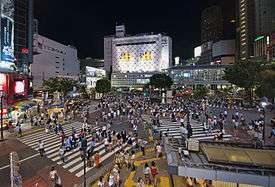
A pedestrian scramble, also known as scramble intersection (Canada), 'X' Crossing (UK), diagonal crossing (US), exclusive pedestrian interval, and more poetically a Barnes Dance, is a type of traffic signal movement that temporarily stops all vehicular traffic, thereby allowing pedestrians to cross an intersection in every direction, including diagonally, at the same time.
It was first used in Canada and the United States in the late 1940s, but it later fell out of favor with traffic engineers in Canada and United States, as it was seen as prioritizing flow of pedestrians over flow of car traffic. However, it prioritizes pedestrians over vehicles only during a portion of the traffic control cycle, but it prioritizes vehicles over pedestrians for the remainder of the cycle. Its benefits for pedestrian amenity and safety have led to new examples being installed in many countries in recent years.
Development

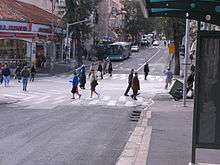
The name "Barnes Dance" commemorates traffic engineer Henry Barnes. While he did not claim to have invented it himself, Barnes was a strong advocate of it, having observed the difficulties his daughter experienced on her way to school.[1] He first introduced it in his home city of Denver, Colorado in the late 1940s.[2] Around this time, the pedestrian scramble was being tested separately in Kansas City and Vancouver.[3] Barnes later brought it to Baltimore and New York City.[4] When Barnes became traffic commissioner of New York City in 1962, his first action was to look for intersections to implement pedestrian scrambles. The first pedestrian scramble was installed ten days after he took office at the intersection of Vanderbilt Avenue and 42nd Street, to great acclaim.[5] Following the success of this first scramble, Barnes began adding more scrambles across the city, at Wall Street;[6] 42nd Street at Fifth Avenue and at Madison Avenue;[7] and Brooklyn.[8]
In his autobiography The Man With the Red and Green Eyes (1965) Barnes recorded that a City Hall reporter, John Buchanan, first coined the phrase by writing that "Barnes has made the people so happy they're dancing in the streets."[9] Barnes later said, "As things stood now, a downtown shopper needed a four-leaf clover, a voodoo charm, and a St. Christopher's medal to make it in one piece from one curbstone to the other. As far as I was concerned — a traffic engineer with Methodist leanings — I didn't think that the Almighty should be bothered with problems which we, ourselves, were capable of solving."[3]
However, the Barnes Dance—officially known as an "exclusive pedestrian interval" because vehicular traffic is stopped in all directions during a pedestrian scramble—caused gridlock in some cities where it was implemented, such as New York City, where congestion increased due to longer wait times for lights.[10] Robert Moses, a New York City urban planner, disliked the scrambles because they held up traffic.[3] In locations such as Washington, D.C., pedestrian scrambles shorten the time allotted to each traffic-signal phase by one-third.[11] One study of exclusive pedestrian intervals in Greenwich, Connecticut, found that it offered no extra benefits compared to a "concurrent pedestrian interval" where pedestrians cross when parallel traffic has the green light.[12] In the United States, the 2009 Manual on Uniform Traffic Control Devices allows pedestrian scrambles.[13]
Application
In Australia
In Adelaide, there are two scrambles on either end of Rundle Mall, King William Street and another on Pulteney Street. There is another crossing at the intersection of King William Street, Waymouth Street and Pirie Street.
In Brisbane, there are two noteworthy scrambles: one in the central business district at the intersection of Adelaide and Edward Streets, adjacent to the Queen Street Mall and an entrance to Translink's Central Station, and a second at the intersection of Vulture and Boundary Streets in the eclectic West End suburb. In Darwin, there is a pedestrian scramble at the CBD end of Smith St Mall.
In Melbourne, there is a pedestrian scramble at the intersection of Flinders and Elizabeth Streets, in front of Flinders Street railway station, allowing pedestrians to walk directly to the station and the two island tram platforms in the middle of both streets.
In Sydney, there are numerous examples in built-up commercial and CBD areas, like the intersection of George and Druitt Streets (with one of the corner blocks being the Sydney Town Hall), Church Street in Parramatta also has them, as does the Fairfield, New South Wales central business district.
In Canada
Vancouver was one of the first cities worldwide to use the concept at individual locations. London, Ontario, had a Barnes' Dance crosswalk in the 1960s at the intersection of Clarence and King streets. In Toronto, the intersection of Yonge Street and Dundas Street, the location of Yonge-Dundas Square, has the city's first installed scramble intersection[14] and has since been joined by two more on Bloor Street at Yonge and Bay Streets in the downtown area. In 2015, Toronto has eliminated the Bay and Bloor scramble crossing after an evaluation study found 'modest positive benefits for pedestrians' and 'negative impacts to vehicular traffic'. The staff report also noted that sideswipe collisions at Bay and Bloor have more than doubled and rear-end type crashes have increased by 50% “likely due to increased driver frustration”.[15] As of September 2015, Kingston, Ontario, will have a scramble crosswalk at the corners of Union Street and University Avenue to increase the safety of Queen's University students. Calgary has two pedestrian scrambles in the Eau Claire neighbourhood. St. Albert, Alberta has installed a test pedestrian scramble as of the end of May, 2017. Quebec City and Banff also have a few pedestrian scramble intersections.
In Japan
Pedestrian scrambles, known as a scramble crossing (スクランブル交差点 sukuranburu-kōsaten), are very common in Japan, where more than over 300 such intersections exist. Japan's largest, and most famous, diagonal crossing is found in Tokyo, outside Shibuya station[16] Over 3,000 pedestrians can cross in one scramble and has become a symbol of Tokyo and Japan as a whole.[17] Sukiyabashi in Ginza is another large scramble crossing in Tokyo.
Kansai also has many diagonal crossings, including four outside the north exit of Kyoto Station alone. Most of the diagonal crossings in Osaka are located in the south of the city, in Abeno ward.
The first diagonal crossing to be installed in Japan was in the Kyushu city of Kumamoto in 1969.
In the Netherlands
In the Netherlands, a version of this crossing, called a Simultaneous Green light for Bicyclists, combined with an all way green light for pedestrians, is currently being used in a number of intersections in the North and East of the Netherlands.
In New Zealand
In New Zealand, the first Barnes Dance was introduced in 1958 on Queen Street, Auckland, and was soon found in other cities as well.[1] The Queen Street examples are Custom Street, Shortland, Wyndham, Victoria and Wellesley Street intersections. When Mayoral Drive was constructed in the 1970s it was not created as a Barnes Dance -indicative of a change in traffic management models.
The Queen Street crossings remain today, despite early 2000s attempts to remove them for greater car priority, and have been extended with greater numbers of phases and pedestrian green times during the late 2000s.
Additionally, some Barnes Dance intersections do not provide painted crossings and are therefore de facto, such as the intersection of Grafton Rd and Symonds St within the University of Auckland city campus. Karangahape Road had two such crossings – the Queen Street / K Road intersection was modified in the 1990s but the Pitt Street / K Road intersection is still a Barnes Dance. On nearby Ponsonby Road there is a Barnes Dance at Franklin Road. There is a Barnes Dance on the Great North Road at the Surrey Crescent intersection with Williamson Avenue. There is also a Barnes Dance at the multiple street intersection of Lake Road, Hurstmere Road, Northcroft Street and The Strand in Takapuna.
Barnes Dances also existed in several other cities in New Zealand, notably on Colombo Street, Christchurch and at Cargill's Corner in South Dunedin, but have been gradually phased out. The only Barnes Dance remaining in the South Island at present is on Stafford Street in Timaru and three in the Christchurch CBD.
In the United Kingdom
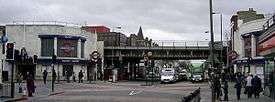
In London, the first formal diagonal crossing built in the UK was opened in Balham town centre in 2005. The success of the Balham crossing was followed by conversion of the existing crossing facilities at Oxford Circus in 2009,[18] Further diagonal crossings were constructed in Wood Green in 2010 and Wimbledon in 2012.
Swansea opened a diagonal crossing in 2015.
Harrogate also opened a diagonal crossing in 2015. Since opening, some have criticized it for being too confusing and claim that its poor design led to the death of an elderly pedestrian who was struck by a vehicle in its first year of operation.
In the United States
Kansas City was one of the first cities that used a pedestrian scramble system at a few locations.[2] Denver formerly used the pedestrian scramble system at nearly every intersection in the downtown business district. The practice was eliminated on 11 April 2011, in order to "balance" resources allotted to pedestrians, vehicles, and mass transit. Exclusive pedestrian intervals were kept, but the diagonal crossing was made illegal.[19][20]
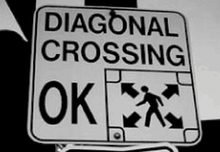
In Boston, most signalized intersections use an exclusive pedestrian phase, where vehicular traffic is stopped in all directions and it is possible for fast walkers to cross the street diagonally (even though the crosswalks are not marked as such). However, a growing number of traffic signals are being programmed to use a concurrent pedestrian phase.[21] A similar situation exists in Cambridge, Massachusetts, where intersections with exclusive intervals can allow fast walkers to cross the street diagonally.[22]
In Washington, D.C., diagonal crossing existed at several downtown intersections until the mid-1980s. It is being tried again on an experimental basis at 7th and H streets Northwest beginning May 2010.[23]
In New Haven, all of the intersections with traffic lights have implemented the pedestrian scramble, since at least 1974.

In New York City, there are numerous signals with a pedestrian scramble phase; those are most often found in intersections with only one vehicle phase.[24] A notable pedestrian scramble exists in Lower Manhattan at the intersection of Vesey Street, Broadway, Park Row, and Ann Street.[25] Another notable scramble occurs at the busy intersection of Nostrand Avenue and Flatbush Avenue in Midwood, Brooklyn; this particular signal was the site of several crashes due to pedestrians crossing against the light, since pedestrians have a "don't walk" signal when vehicles in either direction have a green signal.[26]
Signals at several intersections in Pittsburgh, including along Craig Street at Centre Avenue, Bayard Street, Fifth Avenue, and Forbes Avenue near the University of Pittsburgh; on Forbes at Morewood Street at the main entrance to Carnegie Mellon University; and on Forbes at Murray and Shady Avenues in Squirrel Hill stop traffic from all directions and allow pedestrians to cross in all directions. They are not, however, specially signed; they use a standard pedestrian crossing light (with added audio signal for the visually impaired).
The signal at the intersection of McKinley and Riverside Avenues on the campus of Ball State University in Muncie, Indiana, is called the "Scramble Light" and is identified by the university as a campus landmark.[27]
Ohio University in Athens, Ohio, has numerous legal diagonal crosswalks in use around campus, as well as some through uptown.
Some pedestrian scrambles are implemented only temporarily, during times when extremely high pedestrian traffic is expected. A notable example of this occurs on home-game Saturdays at the intersection of Main Street and Stadium Boulevard in Ann Arbor, Michigan, which is immediately adjacent to Michigan Stadium. Local police take control of the vehicular signals and indicate the pedestrian phase by playing Michigan's fight song, "The Victors."
On 31 May 2013, Chicago began testing a pedestrian scramble on the intersection of State Street and Jackson Boulevard.[28]
In Nevada, both Reno and Sparks have pedestrian scramble interchanges. Reno's is at the intersection of Virginia and 2nd Avenue downtown to accommodate casino pedestrian traffic, and Sparks' are along Victorian Avenue to assist people in crossing to festivals that are held along that street.
Seattle uses the pedestrian scramble at 1st and Pike, 1st and University, 1st and Cherry, Beacon and 15th, 15th Ave NE and NE 40th St, and at the West Seattle Junction. The intersections are marked with a sign labeled "All Way Walk."[29] Bellevue, Washington also has one at 108th Avenue NE and the NE 6th Street pedestrian walkway, on the west side of Bellevue Transit Center. It is not signed as an all-way walk, but has pedestrian walk lights, and is accompanied by an auditory alert of "Walk sign is on for all crossings."
In California, San Francisco has several pedestrian scrambles along Stockton Street in Chinatown, Montgomery Street in the Financial District, as well as in several other locations.[30] In Los Angeles County, California, pedestrian scrambles are used in the Rodeo Drive commercial area of Beverly Hills; at the intersection of Westwood Boulevard and Le Conte Avenue as well as Weyburn and Broxton Avenues in the Westwood section of Los Angeles immediately adjacent to the UCLA campus; at the intersection of Hollywood Boulevard and Highland Avenue in Hollywood, and at the intersection of Jefferson Boulevard and McClintock Avenue near the University of Southern California.[31] In 1994, two scrambles were installed in Pasadena, Los Angeles County, along Colorado Boulevard at two intersections: at DeLacey Avenue and at Raymond Avenue.[32] In San Diego, one of the locations that uses pedestrian scrambles is at the intersection of Market Street and 5th Avenue,[33] but the city does not plan to add any additional scrambles.[31] Carlsbad added its first scramble in 2012,[33] and the campus of UC Davis installed a bike/pedestrian scramble near its recreation center in 2014.[34]
.jpg)
The City of El Paso, Texas added pedestrian scramble markings to the intersection of Santa Fe Street and Main Drive in Downtown in April 2015.
In Portland, Oregon, a pedestrian scramble was added in November 2015 to the intersection of NW 11th Avenue and NW Couch Street, near Powell's Books.[35][36]
Multiple pedestrian scrambles were added in the downtown area of Broadway in Nashville, Tennessee, in March 2016.[37]
On 9 May 2017, as part of the New York City Vision Zero program, the city announced that Manhattan may be getting new diagonal crossing intersections, including Lower Manhattan and Union Square. These crosswalks are planned to be installed by the end of 2017.[38]
Advantages and disadvantages
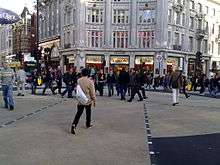
Research at Transport for London has suggested the installation of a diagonal crossing can reduce pedestrian casualties by 38%.[39]
Since it stops all motor vehicles rather than allowing partial vehicle movements to coexist with partial pedestrian movements, the pedestrian scramble has sometimes been seen as inefficient by traffic engineers, with its removal believed as creating big savings in delays and congestion.[10] It benefits drivers by eliminating concurrent pedestrian phases, allowing car traffic to make left or right turns without being blocked by pedestrians in the crosswalk. However, this also results in either longer wait times for both drivers and pedestrians, or shorter traffic-signal phases where less traffic could flow through an intersection in a single cycle.[12]
Proper use requires that both drivers and pedestrians are aware of the traffic rules at such intersections. In some countries, that has led to a removal of at least individual installations. However, critics have dismissed these moves as further subordinating pedestrians to cars and consider the shared turns of motor vehicles and pedestrians as unnecessarily intimidating.[4]
The pedestrian scramble may be used where large numbers of pedestrians are expected, and they will also have enough space to gather on the sidewalks in larger numbers.[40] Under certain circumstances, pedestrian scrambles could reduce safety, as the average waiting times for pedestrians and car drivers are increased, thus creating more likelihood of people disobeying the signals.[41]
See also
References
- 1 2 "Today In History, 21 August". New Zealand History. New Zealand History online. Retrieved 6 July 2010.
- 1 2 "Where was the First Walk/Don't Walk Sign Installed? Addendum: The Barnes Dance". Federal Highway Administration. Retrieved 6 July 2010.
- 1 2 3 Jaffe, Eric (18 December 2012). "A Brief History of the Barnes Dance". CityLab. Retrieved 24 February 2017.
- 1 2 "Rudman's city: Car-crazy engineers set on banning the Barnes dance". The New Zealand Herald. 8 August 2001. Retrieved 6 July 2010.
- ↑ Phillips, Mccandlish (26 January 1962). "42d an All-Way Street in Pedestrian Test; Pedestrians Test Crossing Plan At 42d St. and Vanderbilt Ave.". The New York Times. ISSN 0362-4331. Retrieved 24 February 2017.
- ↑ Stengren, Bernard (14 March 1962). "WALL STREET DOES THE BARNES DANCE; All-Red Light System Tried Out at Broadway Corner". The New York Times. ISSN 0362-4331. Retrieved 24 February 2017.
- ↑ "Fifth and Madison At 42d St. to Try Barnes Scramble". The New York Times. 26 March 1962. ISSN 0362-4331. Retrieved 24 February 2017.
- ↑ Stengren, Bernard (20 April 1962). "Brooklyn Stumbles During Its First Barnes Dance". The New York Times. ISSN 0362-4331. Retrieved 24 February 2017.
- ↑ "Highway History: The Barnes Dance". U.S. Department of Transportation, Federal Highway Administration.
- 1 2 "Death by Car". NYMag.com. December 2012. Retrieved 24 February 2017.
- ↑ Kelly, John (7 October 2014). "Crosswalks in the crossfire: Pondering pedestrian etiquette in downtown D.C.". Washington Post. Retrieved 9 March 2017.
- 1 2 "Exclusive vs. Concurrent Pedestrian Phase Crossing" (PDF). greenwichct.org. DPW Engineering Division. Retrieved 24 February 2017.
- ↑ "Chapter 4E – MUTCD 2009 Edition". Federal Highway Administration. Retrieved 24 February 2017.
- ↑ Spears, John (28 August 2008). "Pedestrians first at Yonge and Dundas". The Star. Toronto.
- ↑ "Vote Bay-Bloor pedestrian scramble closer to dying | Toronto Star". thestar.com. Retrieved 7 March 2017.
- ↑ Murray Buechner, Maryanne. "Tokyo: 10 Things To Do". Time: Travel.
- ↑ "【 渋谷センター街 】ウェブサイト". center-gai.jp (in Japanese). Retrieved 7 March 2017.
- ↑ "BBC News – Oxford Circus 'X-crossing' opens". Retrieved 24 February 2017.
- ↑ Meyer, Jeremy P. (6 April 2011). "Denver to eliminate diagonal crossings at intersections "Barnes Dance" to end". The Denver Post. Retrieved 6 April 2011.
- ↑ Stanley, Deb (11 April 2011). "Denver Eliminates Diagonal Crosswalks Today". KMGH Denver. Retrieved 28 March 2012.
- ↑ "Pedestrian Signal Phasing Study". Retrieved 24 February 2017.
- ↑ Cambridge, City of. "Concurrent Pedestrian Signals – Traffic, Parking & Transportation Department – City of Cambridge, Massachusetts". Retrieved 24 February 2017.
- ↑ "WTOP: Washington, DC's Top News, Traffic, and Weather". Retrieved 24 February 2017.
- ↑ "NYC DOT: Exclusive Pedestrian Signals". nyc.gov. New York City Department of Transportation. Retrieved 24 February 2017.
- ↑ "NYC Pols: Bring Barnes Dance Back for Most Dangerous Intersections". Next City. 11 May 2016. Retrieved 24 February 2017.
- ↑ "Flatbush Avenue Pedestrian Study – Location: Flatbush Avenue and Nostrand Avenue/ Hillel Place" (PDF). nyc.gov. New York City Department of Transportation. Retrieved 24 February 2017.
- ↑ "Scramble Light". Ball State University. Retrieved 8 January 2016.
- ↑ Hilkevitch, Jon (31 May 2013). "Loop intersection begins test of 'pedestrian scramble'". Chicago Tribune. Tribune Company. Retrieved 1 June 2013.
- ↑ Ellwanger, Jim (5 June 2011). Illustration of claustrophobia. Downtown Seattle: Flickr. Retrieved 4 April 2012.
- ↑ "11 January 2008 Working Draft San Francisco PedSafe Phase II Final Report and Executive Summary". Federal Highway Administration. Retrieved 18 April 2011.
- 1 2 Karlamangla, Soumya. "Diagonal walkways put drivers, pedestrians at different cross purposes". latimes.com. Retrieved 24 February 2017.
- ↑ Pool, Bob (9 April 1994). "'At first I said: "No way, it's too scary. I'm not walking through the middle of an intersection. We'll get hit by a car." ' : Pasadena Pedestrians Get New Slant on Crowded Crosswalks". Los Angeles Times. ISSN 0458-3035. Retrieved 24 February 2017.
- 1 2 McCray, Tawny Maya. "Carlsbad installs diagonal crosswalk at busy intersection". sandiegouniontribune.com. Retrieved 24 February 2017.
- ↑ "Davis Creates Protected Intersection to Maintain Public Safety | PublicCEO". www.publicceo.com. Retrieved 24 February 2017.
- ↑ "Portland's first all-way crossing, a 'pedestrian scramble,' coming to Pearl District". OregonLive.com. Retrieved 24 February 2017.
- ↑ "New signals on Couch at Broadway and first-ever ‘pedestrian scramble’ are up and running". Bike Portland. Retrieved 24 November 2015.
- ↑ "‘Pedestrian scramble’ crosswalks come to downtown Nashville". WKRN.com. 8 March 2016. Retrieved 24 February 2017.
- ↑ "Manhattan May Be Getting Diagonal Crossings in Some Locations". 9 May 2017.
- ↑ "Oxford Circus Diagonal Crossing: Lessons Learned Report" (PDF). thinkingwriting.qmul.ac.uk. Transport for London. March 2010. Retrieved 24 February 2017.
- ↑ "Hall Monitor: A new way to cross the street – diagonally". National Post Toronto: Posted Toronto. 23 July 2008. Retrieved 6 July 2010.
- ↑ Bechtel, Allyson K. "Oakland Chinatown Pedestrian Scramble". University of California Traffic Safety Center. Retrieved 6 July 2010.
External links
| Wikimedia Commons has media related to Pedestrian scrambles. |